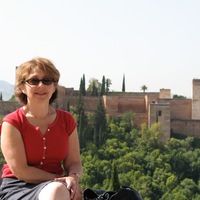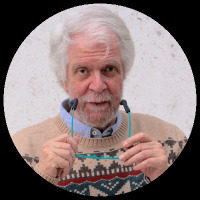Books by Olga Bush

finalist for the 2019 Charles Rufus Morey Book Award, which "honors an especially distinguished b... more finalist for the 2019 Charles Rufus Morey Book Award, which "honors an especially distinguished book in the history of art, published in the English language" (College Art Association).
The Nasrid builders of the Alhambra – the best-preserved medieval Muslim palatial city – were so exacting that some of their work could not be fully explained until the invention of fractal geometry. Their design principles have been obscured, however, by the loss of all archival material. This book resolves that impasse by investigating the neglected, interdisciplinary contexts of medieval poetics and optics and through comparative study of Islamic court ceremonials. This reframing enables the reconstruction of the underlying, integrated aesthetic, focusing on the harmonious interrelationship between diverse artistic media – architecture, poetry and textiles – in the experience of the beholder, resulting in a new understanding of the Alhambra.
Table of Contents
List of Figures
Series Editor's Foreword
Acknowledgments
Introduction
Chapter 1. Colour, Design and Medieval Optics
Chapter 2. Addressing the Beholder: The Work of Poetic Inscriptions
Chapter 3. Qalahurra of Yusuf I: A Case Study of a Tower-Palace
Chapter 4. "Textile Architecture" in the Cuarto Dorado
Chapter 5. Integrating Aesthetic and Politics: The Mawlid Celebration in the Alhambra
Appendix
Bibliography
Illustration Acknowledgments
Indices
Hardback / Spring 2018 / 344 pages / 94 colour illustrations / ISBN 9781474416504 /
Published by Edinburgh University Press (distributed by Oxford University Press in the Americas) in the Edinburgh Studies in Islamic Art series, edited by Robert Hillenbrand.
Reviews: https://global.oup.com/academic/product/reframing-the-alhambra-9781474416504?lang=en&cc=us#

finalist for the 2019 Charles Rufus Morey Book Award, which "honors an especially distinguished b... more finalist for the 2019 Charles Rufus Morey Book Award, which "honors an especially distinguished book in the history of art, published in the English language" (College Art Association).
The Nasrid builders of the Alhambra – the best-preserved medieval Muslim palatial city – were so exacting that some of their work could not be fully explained until the invention of fractal geometry. Their design principles have been obscured, however, by the loss of all archival material. This book resolves that impasse by investigating the neglected, interdisciplinary contexts of medieval poetics and optics and through comparative study of Islamic court ceremonials. This reframing enables the reconstruction of the underlying, integrated aesthetic, focusing on the harmonious interrelationship between diverse artistic media – architecture, poetry and textiles – in the experience of the beholder, resulting in a new understanding of the Alhambra.
Table of Contents
List of Figures
Series Editor's Foreword
Acknowledgments
Introduction
Chapter 1. Colour, Design and Medieval Optics
Chapter 2. Addressing the Beholder: The Work of Poetic Inscriptions
Chapter 3. Qalahurra of Yusuf I: A Case Study of a Tower-Palace
Chapter 4. "Textile Architecture" in the Cuarto Dorado
Chapter 5. Integrating Aesthetic and Politics: The Mawlid Celebration in the Alhambra
Appendix
Bibliography
Illustration Acknowledgments
Indices
Hardback / Spring 2018 / 344 pages / 94 colour illustrations / ISBN 9781474416504 /
Published by Edinburgh University Press (distributed by Oxford University Press in the Americas) in the Edinburgh Studies in Islamic Art series, edited by Robert Hillenbrand.
Reviews: https://global.oup.com/academic/product/reframing-the-alhambra-9781474416504?lang=en&cc=us#
Reviews of Olga Bush, Reframing the Alhambra by Olga Bush
Articles and Book Chapters by Olga Bush

Didem Ekici, Patricia Blessing, Basile Baudez (eds.), Textile in Architecture: From the Middle Ages to Modernism (New York: Routledge), 138-155 , 2023
This chapter approaches the materiality of the Alhambra through the theory of textility advanced ... more This chapter approaches the materiality of the Alhambra through the theory of textility advanced by Tim Ingold and Victoria Mitchell as modified by consideration of the 10th c. Epistle on Composition by the Brethren of Purity. The contemporary theorists emphasize making, on the model of the fabrication of textiles, as an ongoing process in which use extends the ever-changing life of the work of art. The view leads to the conception of the Alhambra as an environmental artefact in which interior and exterior spaces are interwoven. The Brethren of Purity enhance this environmental theory in their culturally specific understanding of materiality as endowed with life force. Within this mixed theoretical framework, the chapter proceeds to the study of the Alhambra in two stages. First, it grounds the materiality of the “textilic” by outlining the evidence of inter-medial textile architecture, whose chief example is a feature of the Nasrid royal tent that heightens perception of environmental lines of force in airflow. Proceeding then from the flow of air to the flow of water, discussion moves beyond textiles to consider the textilic as it is embodied, above all, in the built environment of the Court of the Lions.

Geometry and Color. Decoding the Arts of Islam in the West from the Mid-19th to the Early 20th Century, edited by Sandra Gianfreda, Francine Giese, Ariane Varela Braga, and Axel Langer, Manazir , 3 , 13-29 , 2021
The dissemination of Owen Jones’ studies of the Alhambra and his color theory has been
increasing... more The dissemination of Owen Jones’ studies of the Alhambra and his color theory has been
increasingly well understood as a cornerstone of the later Alhambresque style. And yet, curiously,
Jones offers at once an accurate appreciation of the Alhambra and a basis for a striking divergence
from Nasrid design in Alhambresque interiors. This article examines that discrepancy. It begins with
a review of the aesthetics of the Alhambra in view of the eleventh-century optics of Ibn al-
Haytham, supported by conservation work that has confirmed Jones’ vibrant colors. The aesthetic
key to the Alhambra is not color alone, however, but a principle of visual harmony integrating color
and geometry. The Nasrid builders applied color in conjunction with principles of proportionate
geometric relationships and measurable visual properties—height, distance, size, depth—in the
architectural and decorative design. They also manipulated color through their consideration of
the materiality of the polychromed surfaces, whose reflective and refractive potentials allowed for
differing optical effects. By balancing attention between color, as transmitted through the innovative
technique of chromolithography, and the drawings of plans and elevations, this article strengthens
the understanding of Jones’ grasp of the visual harmony of the Alhambra. Second, it demonstrates
the ways in which Jones’ plates of various ornament were often privileged over, or simply divorced
from, his architectural drawings in Alhambresque interiors: e.g., the Salón árabe (1847-1851) in the
Royal Palace of Aranjuez (Spain), the Salotto Turco in the Villa Mimbelli (1865-1870) in Livorno (Italy),
and the Moorish Bath (1850-1854) at Schloss Albrechtsberg in Dresden (Germany). In conclusion,
this article proposes that, in contrast to the Alhambra, a loss of visual harmony is a significant
characteristic of the Alhambresque, or, otherwise stated, that the Alhambresque interiors feature a
disproportionate emphasis on color, consistent with the ideological burden of Orientalism.

Al-Andalus in Motion: Travelling Concepts and Cross-Cultural Contexts, edited by Rachel Scott, AbdoolKarim Vakil & Julian Weiss, King's College London Medieval Studies 28 (London: Centre for Late Antique & Medieval Studies, King's College London, 2021), 255-288 , 2021
When in 1919, the neo-mudéjar train station in Toledo was inaugurated, the building was considere... more When in 1919, the neo-mudéjar train station in Toledo was inaugurated, the building was considered by the Academy of Fine Arts, the leading Spanish architects and the distinguished city intellectuals, as an architectural paradigm of modernity and tradition. As an emblem of modernity, it encompassed innovations in industrial materials and methods of construction, new mobility offered by railroad travel to Spanish and foreign visitors, and promising prospects for the city's burgeoning economy. The concept of tradition, which the building's architectural style emblematized, was complex and multifaceted. Since the middle of the 19th century Spain participated in European debate on national architectural styles, embroiled in the politics and ideologies of the emerging nation-states. In the context of raging "Orientalism," Spain laid a claim to its "unique" and "authentic" style, the "Alhambrismo," as an artistic expression of nation's essence and spirit, which was exemplified in Spanish national pavilions at the World's Expositions.
The train station in Toledo, complicates the continuing debate on the national architectural style, by shifting emphasis to regionalism and more specifically to the medieval mudéjar architecture of Toledo. Narciso Clavería y Palacios, an architect educated in the School of Architecture in Madrid, was deeply engaged in the ongoing debate that took place on the pages of two leading architectural journals and in the yearly National Congresses of Spanish architects. In these forums, modern architecture was viewed as inextricably linked to considerations of urban fabric of historic, monumental cities and the questions of its conservation and preservation. City topography and the landscape, as a setting, was voiced with renewed interest, as it presented new challenges for the architects at the time. Clavería addressed various important aspects in his design: the building's site in the visuality of the Toledo's dramatic panorama, depicted by artists since the 16th century; the train station's function as the gate to the city for travelers who arrive by train, and, at the same time, as the city's "face" - the first visual impression in their initial encounter with Toledo; and the far-ranging implications of the neo-mudéjar architectural style, intended to promote the historicized, revival style with deep roots in Toledo's medieval past and its place within Spanish history as Imperial City.

Abstract
The use of poetry in inscriptions on luxury objects is a notable feature in the arts of... more Abstract
The use of poetry in inscriptions on luxury objects is a notable feature in the arts of the Islamicate world, particularly in the case of gifts, in which the verses articulate underlying social relations. Scholars often consider such inscriptions within a frame of literal reference, as alternative sources of documentary evidence and/or as ekphrastic descriptions of the object on which they appear. Moving beyond mimesis, this study takes up the figurative dimensions of poetry, exemplified here by the trope of prosopopeia, which gives a fictive voice to inanimate objects and allows the inscribed gifts to speak for themselves and to their recipients. The essay demonstrates the significance of recited and inscribed poetry in the gift economy of the Islamicate world. It shows the widespread nature of the phenomenon by outlining the history of poetic inscriptions, with special attention to the use of the first-person voice, from Graeco-Roman antiquity to Byzantium and on to the Islamicate world. Narrowing the focus to medieval Iberia, it offers a case study of a tenth-century ivory pyxis made near Umayyad Cordoba to test the value of introducing a theory of prosopopeia, and the analysis of poetic figuration more generally, to the study of luxury gifts in the Islamicate world. Prosopopeia, I argue, makes objects into subjects through the speaking “I,” and with the performance of subjectivity comes the construction of agency. In the case of the Umayyad pyxis, a reading attentive to the prosopopeia in the inscription helps restore agency to women in the gift exchange.

This article explores Doris Duke's (1912-93) practices as the 'creative persona' in building Shan... more This article explores Doris Duke's (1912-93) practices as the 'creative persona' in building Shangri La, both her home in Hawai'i and the fifth largest collection of Islamic art in America. Discussion begins with historical contextualization. A brief review of elite collecting in the 1930's extends the timeline of American orientalism to Duke's project at Shangri La. Enabled by the emergence of interior design as a field for women's creativity, her practices as the first major western female collector of Islamic art are considered against American orientalism's gendered slant. Thereafter, the discussion turns to theoretical concerns. First, Duke's deliberately hybrid spaces, mixing Islamic art from various regions and also combining historical objects with replicas, is studied as the creation of an Islamicate dwelling place, which, contrary to the colonial bases of orientalism, recognized the contemporaneity of the Islamic world. Duke's practices of replication and recollection suggest relocation as the conceptual mode in which mobile objects create a sense of the transitory that supplants static architecture. Finally, the concept of relocation enables an examination of Duke's major innovation. She moves Islamic tentage indoors to express her understanding of transitional space in Islamic architecture relocated to its setting in Hawai'i.
The artistic heritage of the Muslim dynasties that made Granada their capital extends beyond the ... more The artistic heritage of the Muslim dynasties that made Granada their capital extends beyond the Alhambra. Many architectural monuments still stand--such as royal residencies, defensive walls and gates, minarets, a mosque courtyard, a bath, an inn, and water cisterns—and together with the unique remains of a madrasa and a hospital, they attest to a complex urban character. The Morisco houses built in the sixteenth century and the new Great Mosque of Granada, inaugurated in 2003, bear the tradition of medieval Muslim architecture past the Christian Reconquest into the modern era. Portable luxury objects in a wide range of media have been preserved in museum collections.











Uploads
Books by Olga Bush
The Nasrid builders of the Alhambra – the best-preserved medieval Muslim palatial city – were so exacting that some of their work could not be fully explained until the invention of fractal geometry. Their design principles have been obscured, however, by the loss of all archival material. This book resolves that impasse by investigating the neglected, interdisciplinary contexts of medieval poetics and optics and through comparative study of Islamic court ceremonials. This reframing enables the reconstruction of the underlying, integrated aesthetic, focusing on the harmonious interrelationship between diverse artistic media – architecture, poetry and textiles – in the experience of the beholder, resulting in a new understanding of the Alhambra.
Table of Contents
List of Figures
Series Editor's Foreword
Acknowledgments
Introduction
Chapter 1. Colour, Design and Medieval Optics
Chapter 2. Addressing the Beholder: The Work of Poetic Inscriptions
Chapter 3. Qalahurra of Yusuf I: A Case Study of a Tower-Palace
Chapter 4. "Textile Architecture" in the Cuarto Dorado
Chapter 5. Integrating Aesthetic and Politics: The Mawlid Celebration in the Alhambra
Appendix
Bibliography
Illustration Acknowledgments
Indices
Hardback / Spring 2018 / 344 pages / 94 colour illustrations / ISBN 9781474416504 /
Published by Edinburgh University Press (distributed by Oxford University Press in the Americas) in the Edinburgh Studies in Islamic Art series, edited by Robert Hillenbrand.
Reviews: https://global.oup.com/academic/product/reframing-the-alhambra-9781474416504?lang=en&cc=us#
The Nasrid builders of the Alhambra – the best-preserved medieval Muslim palatial city – were so exacting that some of their work could not be fully explained until the invention of fractal geometry. Their design principles have been obscured, however, by the loss of all archival material. This book resolves that impasse by investigating the neglected, interdisciplinary contexts of medieval poetics and optics and through comparative study of Islamic court ceremonials. This reframing enables the reconstruction of the underlying, integrated aesthetic, focusing on the harmonious interrelationship between diverse artistic media – architecture, poetry and textiles – in the experience of the beholder, resulting in a new understanding of the Alhambra.
Table of Contents
List of Figures
Series Editor's Foreword
Acknowledgments
Introduction
Chapter 1. Colour, Design and Medieval Optics
Chapter 2. Addressing the Beholder: The Work of Poetic Inscriptions
Chapter 3. Qalahurra of Yusuf I: A Case Study of a Tower-Palace
Chapter 4. "Textile Architecture" in the Cuarto Dorado
Chapter 5. Integrating Aesthetic and Politics: The Mawlid Celebration in the Alhambra
Appendix
Bibliography
Illustration Acknowledgments
Indices
Hardback / Spring 2018 / 344 pages / 94 colour illustrations / ISBN 9781474416504 /
Published by Edinburgh University Press (distributed by Oxford University Press in the Americas) in the Edinburgh Studies in Islamic Art series, edited by Robert Hillenbrand.
Reviews: https://global.oup.com/academic/product/reframing-the-alhambra-9781474416504?lang=en&cc=us#
Reviews of Olga Bush, Reframing the Alhambra by Olga Bush
Articles and Book Chapters by Olga Bush
increasingly well understood as a cornerstone of the later Alhambresque style. And yet, curiously,
Jones offers at once an accurate appreciation of the Alhambra and a basis for a striking divergence
from Nasrid design in Alhambresque interiors. This article examines that discrepancy. It begins with
a review of the aesthetics of the Alhambra in view of the eleventh-century optics of Ibn al-
Haytham, supported by conservation work that has confirmed Jones’ vibrant colors. The aesthetic
key to the Alhambra is not color alone, however, but a principle of visual harmony integrating color
and geometry. The Nasrid builders applied color in conjunction with principles of proportionate
geometric relationships and measurable visual properties—height, distance, size, depth—in the
architectural and decorative design. They also manipulated color through their consideration of
the materiality of the polychromed surfaces, whose reflective and refractive potentials allowed for
differing optical effects. By balancing attention between color, as transmitted through the innovative
technique of chromolithography, and the drawings of plans and elevations, this article strengthens
the understanding of Jones’ grasp of the visual harmony of the Alhambra. Second, it demonstrates
the ways in which Jones’ plates of various ornament were often privileged over, or simply divorced
from, his architectural drawings in Alhambresque interiors: e.g., the Salón árabe (1847-1851) in the
Royal Palace of Aranjuez (Spain), the Salotto Turco in the Villa Mimbelli (1865-1870) in Livorno (Italy),
and the Moorish Bath (1850-1854) at Schloss Albrechtsberg in Dresden (Germany). In conclusion,
this article proposes that, in contrast to the Alhambra, a loss of visual harmony is a significant
characteristic of the Alhambresque, or, otherwise stated, that the Alhambresque interiors feature a
disproportionate emphasis on color, consistent with the ideological burden of Orientalism.
The train station in Toledo, complicates the continuing debate on the national architectural style, by shifting emphasis to regionalism and more specifically to the medieval mudéjar architecture of Toledo. Narciso Clavería y Palacios, an architect educated in the School of Architecture in Madrid, was deeply engaged in the ongoing debate that took place on the pages of two leading architectural journals and in the yearly National Congresses of Spanish architects. In these forums, modern architecture was viewed as inextricably linked to considerations of urban fabric of historic, monumental cities and the questions of its conservation and preservation. City topography and the landscape, as a setting, was voiced with renewed interest, as it presented new challenges for the architects at the time. Clavería addressed various important aspects in his design: the building's site in the visuality of the Toledo's dramatic panorama, depicted by artists since the 16th century; the train station's function as the gate to the city for travelers who arrive by train, and, at the same time, as the city's "face" - the first visual impression in their initial encounter with Toledo; and the far-ranging implications of the neo-mudéjar architectural style, intended to promote the historicized, revival style with deep roots in Toledo's medieval past and its place within Spanish history as Imperial City.
The use of poetry in inscriptions on luxury objects is a notable feature in the arts of the Islamicate world, particularly in the case of gifts, in which the verses articulate underlying social relations. Scholars often consider such inscriptions within a frame of literal reference, as alternative sources of documentary evidence and/or as ekphrastic descriptions of the object on which they appear. Moving beyond mimesis, this study takes up the figurative dimensions of poetry, exemplified here by the trope of prosopopeia, which gives a fictive voice to inanimate objects and allows the inscribed gifts to speak for themselves and to their recipients. The essay demonstrates the significance of recited and inscribed poetry in the gift economy of the Islamicate world. It shows the widespread nature of the phenomenon by outlining the history of poetic inscriptions, with special attention to the use of the first-person voice, from Graeco-Roman antiquity to Byzantium and on to the Islamicate world. Narrowing the focus to medieval Iberia, it offers a case study of a tenth-century ivory pyxis made near Umayyad Cordoba to test the value of introducing a theory of prosopopeia, and the analysis of poetic figuration more generally, to the study of luxury gifts in the Islamicate world. Prosopopeia, I argue, makes objects into subjects through the speaking “I,” and with the performance of subjectivity comes the construction of agency. In the case of the Umayyad pyxis, a reading attentive to the prosopopeia in the inscription helps restore agency to women in the gift exchange.
The Nasrid builders of the Alhambra – the best-preserved medieval Muslim palatial city – were so exacting that some of their work could not be fully explained until the invention of fractal geometry. Their design principles have been obscured, however, by the loss of all archival material. This book resolves that impasse by investigating the neglected, interdisciplinary contexts of medieval poetics and optics and through comparative study of Islamic court ceremonials. This reframing enables the reconstruction of the underlying, integrated aesthetic, focusing on the harmonious interrelationship between diverse artistic media – architecture, poetry and textiles – in the experience of the beholder, resulting in a new understanding of the Alhambra.
Table of Contents
List of Figures
Series Editor's Foreword
Acknowledgments
Introduction
Chapter 1. Colour, Design and Medieval Optics
Chapter 2. Addressing the Beholder: The Work of Poetic Inscriptions
Chapter 3. Qalahurra of Yusuf I: A Case Study of a Tower-Palace
Chapter 4. "Textile Architecture" in the Cuarto Dorado
Chapter 5. Integrating Aesthetic and Politics: The Mawlid Celebration in the Alhambra
Appendix
Bibliography
Illustration Acknowledgments
Indices
Hardback / Spring 2018 / 344 pages / 94 colour illustrations / ISBN 9781474416504 /
Published by Edinburgh University Press (distributed by Oxford University Press in the Americas) in the Edinburgh Studies in Islamic Art series, edited by Robert Hillenbrand.
Reviews: https://global.oup.com/academic/product/reframing-the-alhambra-9781474416504?lang=en&cc=us#
The Nasrid builders of the Alhambra – the best-preserved medieval Muslim palatial city – were so exacting that some of their work could not be fully explained until the invention of fractal geometry. Their design principles have been obscured, however, by the loss of all archival material. This book resolves that impasse by investigating the neglected, interdisciplinary contexts of medieval poetics and optics and through comparative study of Islamic court ceremonials. This reframing enables the reconstruction of the underlying, integrated aesthetic, focusing on the harmonious interrelationship between diverse artistic media – architecture, poetry and textiles – in the experience of the beholder, resulting in a new understanding of the Alhambra.
Table of Contents
List of Figures
Series Editor's Foreword
Acknowledgments
Introduction
Chapter 1. Colour, Design and Medieval Optics
Chapter 2. Addressing the Beholder: The Work of Poetic Inscriptions
Chapter 3. Qalahurra of Yusuf I: A Case Study of a Tower-Palace
Chapter 4. "Textile Architecture" in the Cuarto Dorado
Chapter 5. Integrating Aesthetic and Politics: The Mawlid Celebration in the Alhambra
Appendix
Bibliography
Illustration Acknowledgments
Indices
Hardback / Spring 2018 / 344 pages / 94 colour illustrations / ISBN 9781474416504 /
Published by Edinburgh University Press (distributed by Oxford University Press in the Americas) in the Edinburgh Studies in Islamic Art series, edited by Robert Hillenbrand.
Reviews: https://global.oup.com/academic/product/reframing-the-alhambra-9781474416504?lang=en&cc=us#
increasingly well understood as a cornerstone of the later Alhambresque style. And yet, curiously,
Jones offers at once an accurate appreciation of the Alhambra and a basis for a striking divergence
from Nasrid design in Alhambresque interiors. This article examines that discrepancy. It begins with
a review of the aesthetics of the Alhambra in view of the eleventh-century optics of Ibn al-
Haytham, supported by conservation work that has confirmed Jones’ vibrant colors. The aesthetic
key to the Alhambra is not color alone, however, but a principle of visual harmony integrating color
and geometry. The Nasrid builders applied color in conjunction with principles of proportionate
geometric relationships and measurable visual properties—height, distance, size, depth—in the
architectural and decorative design. They also manipulated color through their consideration of
the materiality of the polychromed surfaces, whose reflective and refractive potentials allowed for
differing optical effects. By balancing attention between color, as transmitted through the innovative
technique of chromolithography, and the drawings of plans and elevations, this article strengthens
the understanding of Jones’ grasp of the visual harmony of the Alhambra. Second, it demonstrates
the ways in which Jones’ plates of various ornament were often privileged over, or simply divorced
from, his architectural drawings in Alhambresque interiors: e.g., the Salón árabe (1847-1851) in the
Royal Palace of Aranjuez (Spain), the Salotto Turco in the Villa Mimbelli (1865-1870) in Livorno (Italy),
and the Moorish Bath (1850-1854) at Schloss Albrechtsberg in Dresden (Germany). In conclusion,
this article proposes that, in contrast to the Alhambra, a loss of visual harmony is a significant
characteristic of the Alhambresque, or, otherwise stated, that the Alhambresque interiors feature a
disproportionate emphasis on color, consistent with the ideological burden of Orientalism.
The train station in Toledo, complicates the continuing debate on the national architectural style, by shifting emphasis to regionalism and more specifically to the medieval mudéjar architecture of Toledo. Narciso Clavería y Palacios, an architect educated in the School of Architecture in Madrid, was deeply engaged in the ongoing debate that took place on the pages of two leading architectural journals and in the yearly National Congresses of Spanish architects. In these forums, modern architecture was viewed as inextricably linked to considerations of urban fabric of historic, monumental cities and the questions of its conservation and preservation. City topography and the landscape, as a setting, was voiced with renewed interest, as it presented new challenges for the architects at the time. Clavería addressed various important aspects in his design: the building's site in the visuality of the Toledo's dramatic panorama, depicted by artists since the 16th century; the train station's function as the gate to the city for travelers who arrive by train, and, at the same time, as the city's "face" - the first visual impression in their initial encounter with Toledo; and the far-ranging implications of the neo-mudéjar architectural style, intended to promote the historicized, revival style with deep roots in Toledo's medieval past and its place within Spanish history as Imperial City.
The use of poetry in inscriptions on luxury objects is a notable feature in the arts of the Islamicate world, particularly in the case of gifts, in which the verses articulate underlying social relations. Scholars often consider such inscriptions within a frame of literal reference, as alternative sources of documentary evidence and/or as ekphrastic descriptions of the object on which they appear. Moving beyond mimesis, this study takes up the figurative dimensions of poetry, exemplified here by the trope of prosopopeia, which gives a fictive voice to inanimate objects and allows the inscribed gifts to speak for themselves and to their recipients. The essay demonstrates the significance of recited and inscribed poetry in the gift economy of the Islamicate world. It shows the widespread nature of the phenomenon by outlining the history of poetic inscriptions, with special attention to the use of the first-person voice, from Graeco-Roman antiquity to Byzantium and on to the Islamicate world. Narrowing the focus to medieval Iberia, it offers a case study of a tenth-century ivory pyxis made near Umayyad Cordoba to test the value of introducing a theory of prosopopeia, and the analysis of poetic figuration more generally, to the study of luxury gifts in the Islamicate world. Prosopopeia, I argue, makes objects into subjects through the speaking “I,” and with the performance of subjectivity comes the construction of agency. In the case of the Umayyad pyxis, a reading attentive to the prosopopeia in the inscription helps restore agency to women in the gift exchange.